Analyzing the Management of Change, Resistance, and Ethics: An Essay
VerifiedAdded on 2020/05/11
|9
|2996
|66
Essay
AI Summary
This essay provides a comprehensive overview of change management within organizations. It begins by highlighting the importance of change and its impact on business operations, while also addressing the key challenges and barriers associated with resistance to change. The essay delves into the relationship between resistance and power, examining how power dynamics influence change implementation. Furthermore, it explores the ethical issues that arise in the context of power and conflict during organizational change, emphasizing the importance of ethical considerations for long-term success. The paper also discusses the managerial implications of change management, including the steps involved in the change process, such as identifying issues, choosing solutions, and evaluating outcomes. The essay also underscores the significance of sustainable human resource management and concludes by emphasizing the need to effectively manage change to maximize organizational growth and achieve objectives. This essay offers insights into the crucial aspects of navigating organizational change, including resistance, power, and ethical considerations.
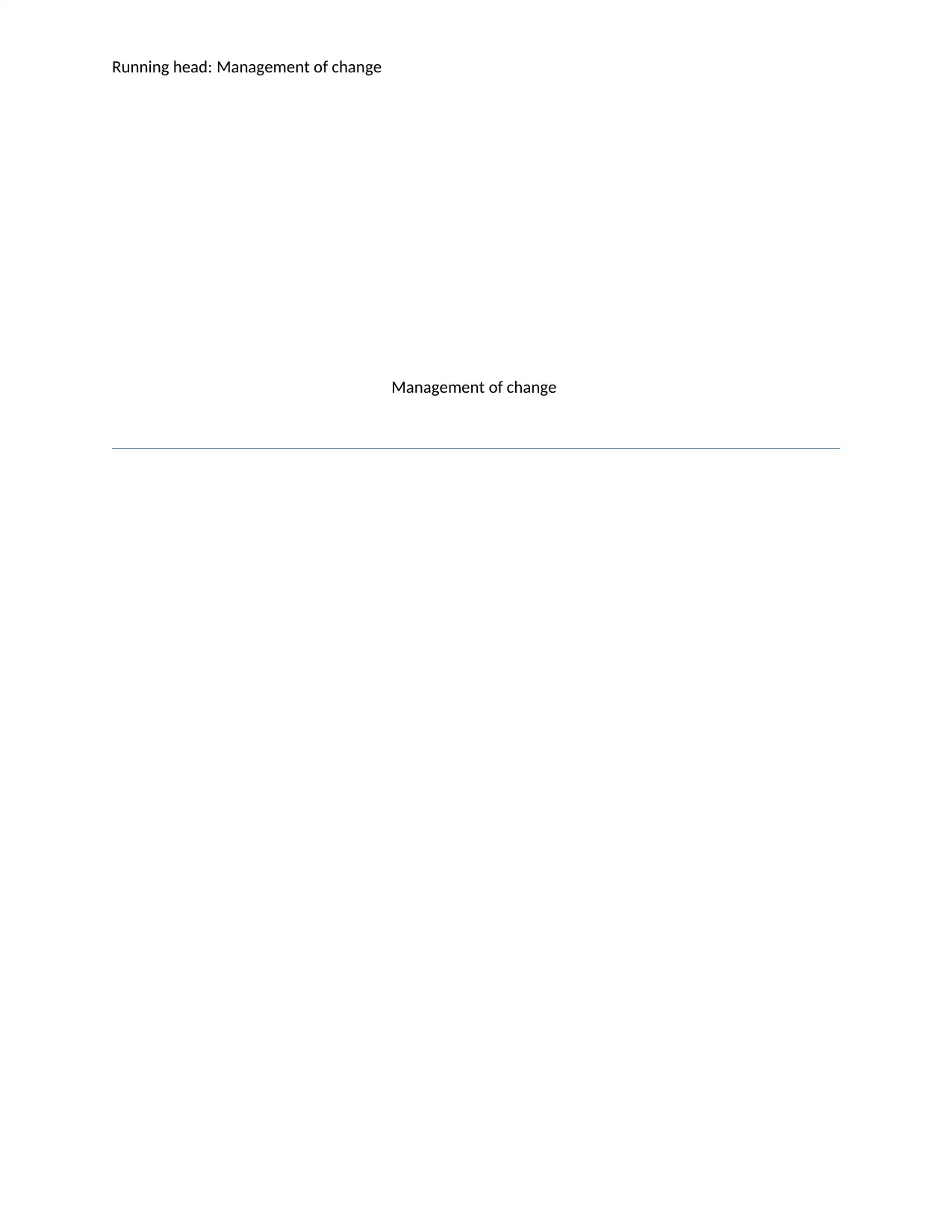
Running head: Management of change
Management of change
Management of change
Paraphrase This Document
Need a fresh take? Get an instant paraphrase of this document with our AI Paraphraser
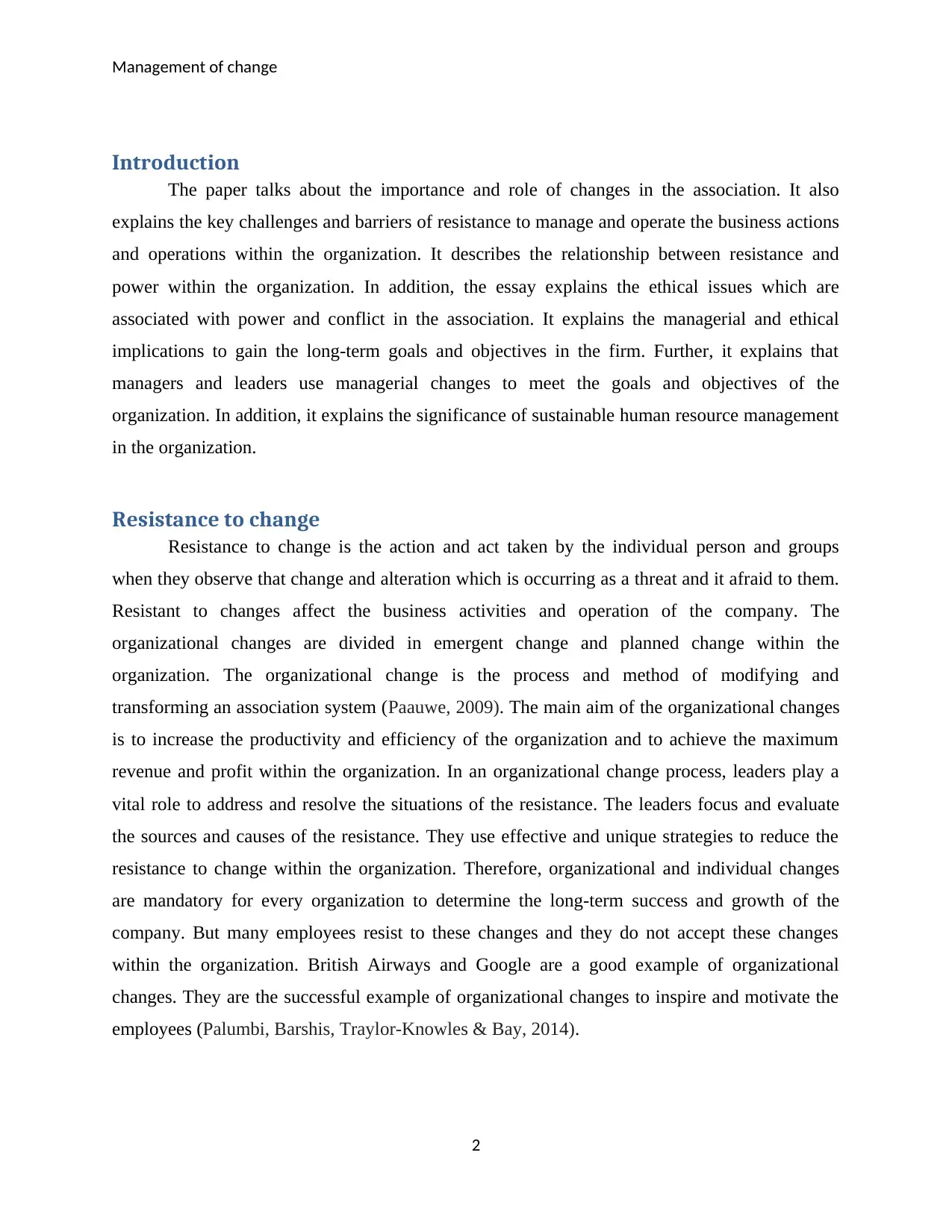
Management of change
Introduction
The paper talks about the importance and role of changes in the association. It also
explains the key challenges and barriers of resistance to manage and operate the business actions
and operations within the organization. It describes the relationship between resistance and
power within the organization. In addition, the essay explains the ethical issues which are
associated with power and conflict in the association. It explains the managerial and ethical
implications to gain the long-term goals and objectives in the firm. Further, it explains that
managers and leaders use managerial changes to meet the goals and objectives of the
organization. In addition, it explains the significance of sustainable human resource management
in the organization.
Resistance to change
Resistance to change is the action and act taken by the individual person and groups
when they observe that change and alteration which is occurring as a threat and it afraid to them.
Resistant to changes affect the business activities and operation of the company. The
organizational changes are divided in emergent change and planned change within the
organization. The organizational change is the process and method of modifying and
transforming an association system (Paauwe, 2009). The main aim of the organizational changes
is to increase the productivity and efficiency of the organization and to achieve the maximum
revenue and profit within the organization. In an organizational change process, leaders play a
vital role to address and resolve the situations of the resistance. The leaders focus and evaluate
the sources and causes of the resistance. They use effective and unique strategies to reduce the
resistance to change within the organization. Therefore, organizational and individual changes
are mandatory for every organization to determine the long-term success and growth of the
company. But many employees resist to these changes and they do not accept these changes
within the organization. British Airways and Google are a good example of organizational
changes. They are the successful example of organizational changes to inspire and motivate the
employees (Palumbi, Barshis, Traylor-Knowles & Bay, 2014).
2
Introduction
The paper talks about the importance and role of changes in the association. It also
explains the key challenges and barriers of resistance to manage and operate the business actions
and operations within the organization. It describes the relationship between resistance and
power within the organization. In addition, the essay explains the ethical issues which are
associated with power and conflict in the association. It explains the managerial and ethical
implications to gain the long-term goals and objectives in the firm. Further, it explains that
managers and leaders use managerial changes to meet the goals and objectives of the
organization. In addition, it explains the significance of sustainable human resource management
in the organization.
Resistance to change
Resistance to change is the action and act taken by the individual person and groups
when they observe that change and alteration which is occurring as a threat and it afraid to them.
Resistant to changes affect the business activities and operation of the company. The
organizational changes are divided in emergent change and planned change within the
organization. The organizational change is the process and method of modifying and
transforming an association system (Paauwe, 2009). The main aim of the organizational changes
is to increase the productivity and efficiency of the organization and to achieve the maximum
revenue and profit within the organization. In an organizational change process, leaders play a
vital role to address and resolve the situations of the resistance. The leaders focus and evaluate
the sources and causes of the resistance. They use effective and unique strategies to reduce the
resistance to change within the organization. Therefore, organizational and individual changes
are mandatory for every organization to determine the long-term success and growth of the
company. But many employees resist to these changes and they do not accept these changes
within the organization. British Airways and Google are a good example of organizational
changes. They are the successful example of organizational changes to inspire and motivate the
employees (Palumbi, Barshis, Traylor-Knowles & Bay, 2014).
2
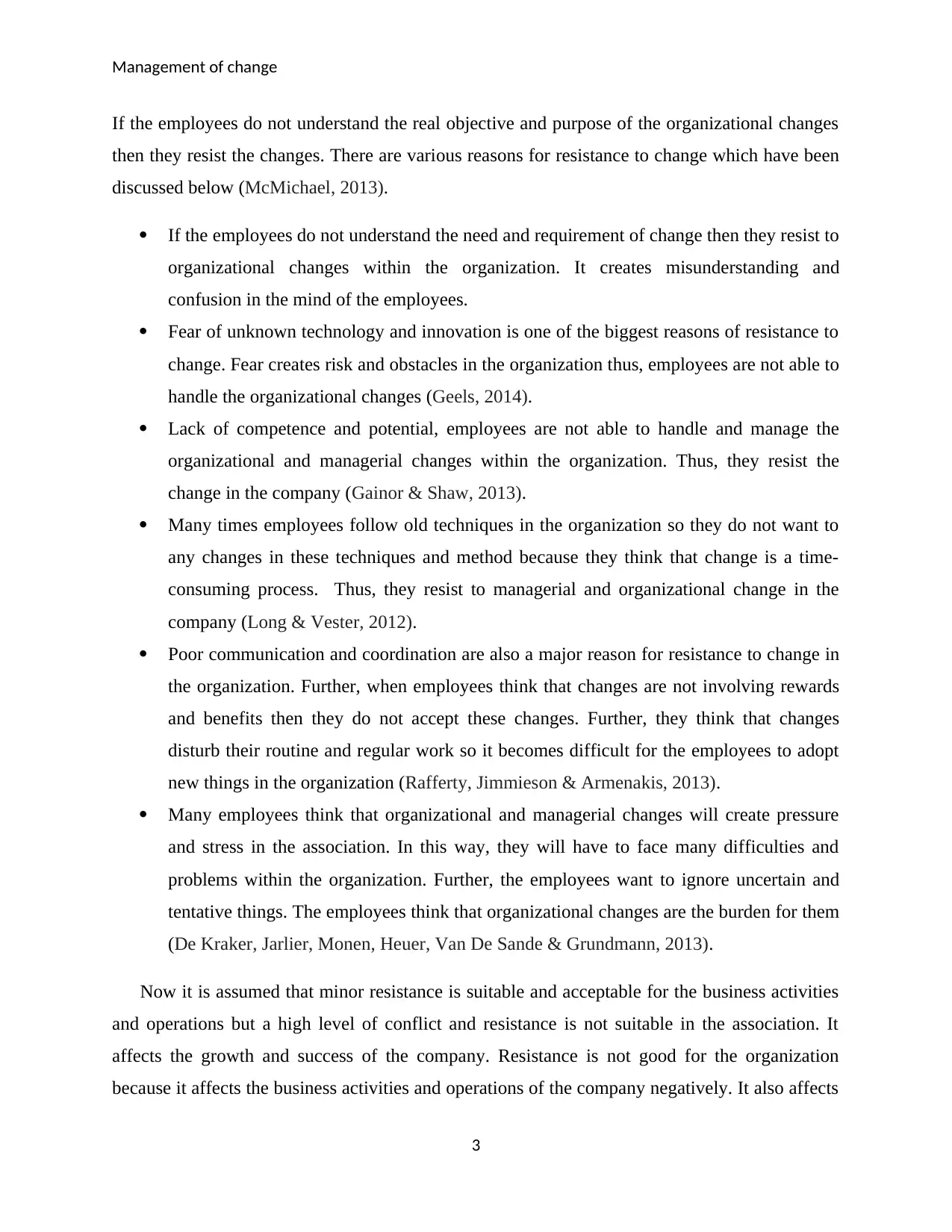
Management of change
If the employees do not understand the real objective and purpose of the organizational changes
then they resist the changes. There are various reasons for resistance to change which have been
discussed below (McMichael, 2013).
If the employees do not understand the need and requirement of change then they resist to
organizational changes within the organization. It creates misunderstanding and
confusion in the mind of the employees.
Fear of unknown technology and innovation is one of the biggest reasons of resistance to
change. Fear creates risk and obstacles in the organization thus, employees are not able to
handle the organizational changes (Geels, 2014).
Lack of competence and potential, employees are not able to handle and manage the
organizational and managerial changes within the organization. Thus, they resist the
change in the company (Gainor & Shaw, 2013).
Many times employees follow old techniques in the organization so they do not want to
any changes in these techniques and method because they think that change is a time-
consuming process. Thus, they resist to managerial and organizational change in the
company (Long & Vester, 2012).
Poor communication and coordination are also a major reason for resistance to change in
the organization. Further, when employees think that changes are not involving rewards
and benefits then they do not accept these changes. Further, they think that changes
disturb their routine and regular work so it becomes difficult for the employees to adopt
new things in the organization (Rafferty, Jimmieson & Armenakis, 2013).
Many employees think that organizational and managerial changes will create pressure
and stress in the association. In this way, they will have to face many difficulties and
problems within the organization. Further, the employees want to ignore uncertain and
tentative things. The employees think that organizational changes are the burden for them
(De Kraker, Jarlier, Monen, Heuer, Van De Sande & Grundmann, 2013).
Now it is assumed that minor resistance is suitable and acceptable for the business activities
and operations but a high level of conflict and resistance is not suitable in the association. It
affects the growth and success of the company. Resistance is not good for the organization
because it affects the business activities and operations of the company negatively. It also affects
3
If the employees do not understand the real objective and purpose of the organizational changes
then they resist the changes. There are various reasons for resistance to change which have been
discussed below (McMichael, 2013).
If the employees do not understand the need and requirement of change then they resist to
organizational changes within the organization. It creates misunderstanding and
confusion in the mind of the employees.
Fear of unknown technology and innovation is one of the biggest reasons of resistance to
change. Fear creates risk and obstacles in the organization thus, employees are not able to
handle the organizational changes (Geels, 2014).
Lack of competence and potential, employees are not able to handle and manage the
organizational and managerial changes within the organization. Thus, they resist the
change in the company (Gainor & Shaw, 2013).
Many times employees follow old techniques in the organization so they do not want to
any changes in these techniques and method because they think that change is a time-
consuming process. Thus, they resist to managerial and organizational change in the
company (Long & Vester, 2012).
Poor communication and coordination are also a major reason for resistance to change in
the organization. Further, when employees think that changes are not involving rewards
and benefits then they do not accept these changes. Further, they think that changes
disturb their routine and regular work so it becomes difficult for the employees to adopt
new things in the organization (Rafferty, Jimmieson & Armenakis, 2013).
Many employees think that organizational and managerial changes will create pressure
and stress in the association. In this way, they will have to face many difficulties and
problems within the organization. Further, the employees want to ignore uncertain and
tentative things. The employees think that organizational changes are the burden for them
(De Kraker, Jarlier, Monen, Heuer, Van De Sande & Grundmann, 2013).
Now it is assumed that minor resistance is suitable and acceptable for the business activities
and operations but a high level of conflict and resistance is not suitable in the association. It
affects the growth and success of the company. Resistance is not good for the organization
because it affects the business activities and operations of the company negatively. It also affects
3
⊘ This is a preview!⊘
Do you want full access?
Subscribe today to unlock all pages.

Trusted by 1+ million students worldwide
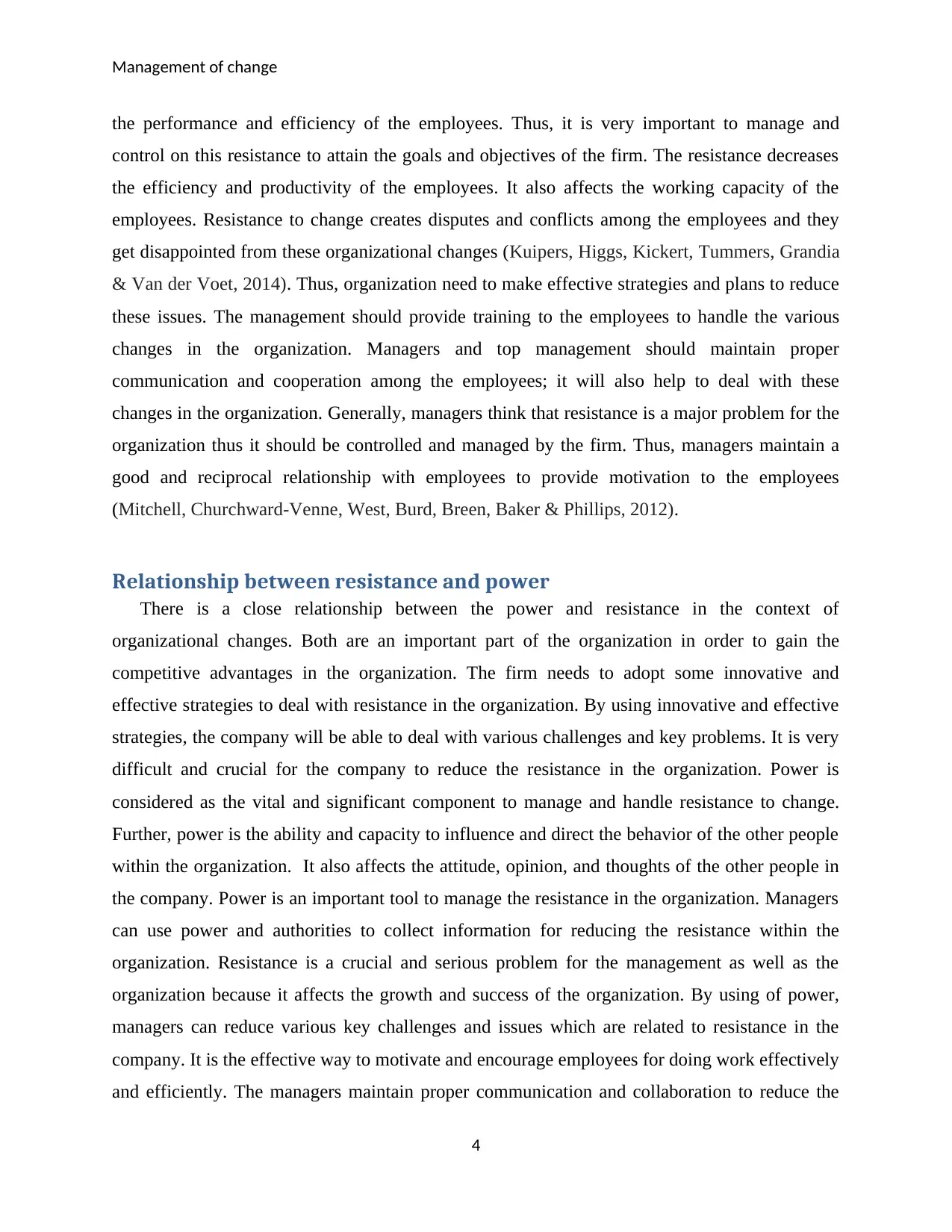
Management of change
the performance and efficiency of the employees. Thus, it is very important to manage and
control on this resistance to attain the goals and objectives of the firm. The resistance decreases
the efficiency and productivity of the employees. It also affects the working capacity of the
employees. Resistance to change creates disputes and conflicts among the employees and they
get disappointed from these organizational changes (Kuipers, Higgs, Kickert, Tummers, Grandia
& Van der Voet, 2014). Thus, organization need to make effective strategies and plans to reduce
these issues. The management should provide training to the employees to handle the various
changes in the organization. Managers and top management should maintain proper
communication and cooperation among the employees; it will also help to deal with these
changes in the organization. Generally, managers think that resistance is a major problem for the
organization thus it should be controlled and managed by the firm. Thus, managers maintain a
good and reciprocal relationship with employees to provide motivation to the employees
(Mitchell, Churchward-Venne, West, Burd, Breen, Baker & Phillips, 2012).
Relationship between resistance and power
There is a close relationship between the power and resistance in the context of
organizational changes. Both are an important part of the organization in order to gain the
competitive advantages in the organization. The firm needs to adopt some innovative and
effective strategies to deal with resistance in the organization. By using innovative and effective
strategies, the company will be able to deal with various challenges and key problems. It is very
difficult and crucial for the company to reduce the resistance in the organization. Power is
considered as the vital and significant component to manage and handle resistance to change.
Further, power is the ability and capacity to influence and direct the behavior of the other people
within the organization. It also affects the attitude, opinion, and thoughts of the other people in
the company. Power is an important tool to manage the resistance in the organization. Managers
can use power and authorities to collect information for reducing the resistance within the
organization. Resistance is a crucial and serious problem for the management as well as the
organization because it affects the growth and success of the organization. By using of power,
managers can reduce various key challenges and issues which are related to resistance in the
company. It is the effective way to motivate and encourage employees for doing work effectively
and efficiently. The managers maintain proper communication and collaboration to reduce the
4
the performance and efficiency of the employees. Thus, it is very important to manage and
control on this resistance to attain the goals and objectives of the firm. The resistance decreases
the efficiency and productivity of the employees. It also affects the working capacity of the
employees. Resistance to change creates disputes and conflicts among the employees and they
get disappointed from these organizational changes (Kuipers, Higgs, Kickert, Tummers, Grandia
& Van der Voet, 2014). Thus, organization need to make effective strategies and plans to reduce
these issues. The management should provide training to the employees to handle the various
changes in the organization. Managers and top management should maintain proper
communication and cooperation among the employees; it will also help to deal with these
changes in the organization. Generally, managers think that resistance is a major problem for the
organization thus it should be controlled and managed by the firm. Thus, managers maintain a
good and reciprocal relationship with employees to provide motivation to the employees
(Mitchell, Churchward-Venne, West, Burd, Breen, Baker & Phillips, 2012).
Relationship between resistance and power
There is a close relationship between the power and resistance in the context of
organizational changes. Both are an important part of the organization in order to gain the
competitive advantages in the organization. The firm needs to adopt some innovative and
effective strategies to deal with resistance in the organization. By using innovative and effective
strategies, the company will be able to deal with various challenges and key problems. It is very
difficult and crucial for the company to reduce the resistance in the organization. Power is
considered as the vital and significant component to manage and handle resistance to change.
Further, power is the ability and capacity to influence and direct the behavior of the other people
within the organization. It also affects the attitude, opinion, and thoughts of the other people in
the company. Power is an important tool to manage the resistance in the organization. Managers
can use power and authorities to collect information for reducing the resistance within the
organization. Resistance is a crucial and serious problem for the management as well as the
organization because it affects the growth and success of the organization. By using of power,
managers can reduce various key challenges and issues which are related to resistance in the
company. It is the effective way to motivate and encourage employees for doing work effectively
and efficiently. The managers maintain proper communication and collaboration to reduce the
4
Paraphrase This Document
Need a fresh take? Get an instant paraphrase of this document with our AI Paraphraser

Management of change
impact of resistance to change at all level of the management. They provide good and healthy
working environment to the employees to increase their productivity in the company. They also
try to provide rewards and incentives to adopt new and innovative things within the organization.
They ask employees about the reason of resistance in the firm. They empower to workers to
adopt the organizational and managerial changes. Managers and top management resolve various
problems that are related to the employees’ resistance (Wallerstein, Tricoli, Barroso, Rodacki,
Russo, Aihara & Ugrinowitsch, 2012).
Ethical issues associated with power and resistance
There are various ethical issues involved in power and resistance that should be controlled by
the firm. The firm adopts the organizational and managerial changes process to gain the long-
term mission and vision of the organization. Ethics and corporate social responsibility play a
vital role to reduce the resistance to change within the organization. The company maintains a
code of conducts and values to manage the resistance to change in the company. The managers
ensure and confirm the satisfaction level of the workers to implement the various changes in the
organization. There are various ethical issues associated with power and resistance in the context
of management change which has been discussed below (Miller, Birch, Mauthner & Jessop,
2012).
The managers use the position to gain the various personal and individual advantages
within the organization. It affects the business activities and operation of the company. It
is the major issue in power and resistance to change. To resolve this issue, the company
should maintain ethical norms and code of conduct for the workers and managers.
Further, the company faces diversity and decision making issues in the organization
while reducing resistance to changes and other key challenges in the organization. It also
faces various governance and compliance issues in the organization (Kshetri, 2013).
The company also faces social and economic issues to implement the changes in the
organization. Due to social issues, employees face many difficulties and they get
disappointed in the firm.
To resolve the ethical issues, top management and managers should perform their task and
duties to handle the organizational and managerial changes in the company. Code of ethics
5
impact of resistance to change at all level of the management. They provide good and healthy
working environment to the employees to increase their productivity in the company. They also
try to provide rewards and incentives to adopt new and innovative things within the organization.
They ask employees about the reason of resistance in the firm. They empower to workers to
adopt the organizational and managerial changes. Managers and top management resolve various
problems that are related to the employees’ resistance (Wallerstein, Tricoli, Barroso, Rodacki,
Russo, Aihara & Ugrinowitsch, 2012).
Ethical issues associated with power and resistance
There are various ethical issues involved in power and resistance that should be controlled by
the firm. The firm adopts the organizational and managerial changes process to gain the long-
term mission and vision of the organization. Ethics and corporate social responsibility play a
vital role to reduce the resistance to change within the organization. The company maintains a
code of conducts and values to manage the resistance to change in the company. The managers
ensure and confirm the satisfaction level of the workers to implement the various changes in the
organization. There are various ethical issues associated with power and resistance in the context
of management change which has been discussed below (Miller, Birch, Mauthner & Jessop,
2012).
The managers use the position to gain the various personal and individual advantages
within the organization. It affects the business activities and operation of the company. It
is the major issue in power and resistance to change. To resolve this issue, the company
should maintain ethical norms and code of conduct for the workers and managers.
Further, the company faces diversity and decision making issues in the organization
while reducing resistance to changes and other key challenges in the organization. It also
faces various governance and compliance issues in the organization (Kshetri, 2013).
The company also faces social and economic issues to implement the changes in the
organization. Due to social issues, employees face many difficulties and they get
disappointed in the firm.
To resolve the ethical issues, top management and managers should perform their task and
duties to handle the organizational and managerial changes in the company. Code of ethics
5

Management of change
should be conducted by the firm to maintain sustainability in the organization. They are
responsible for a code of conducts and ethics within the organization. They have to evaluate and
measures the behavior, attitudes, and customs of the employees. They check and analyze whether
behavior and attitude of the employees are appropriate or not towards the organization. In
addition, they are responsible for organizational and managerial changes process within the
organization. They should reduce unethical and immoral behavior of the employees. They should
focus on the employees’ expectations and requirements in order to achieve the goals and
objectives of the firm (Lozano, 2013).
Managerial implications
Organizational change management is the important and foremost part of the change process
in every organization to meet the long-term goals and objectives of the firm. This management
process is essential to implement and execute various changes within the organization. The
organizational change management process focuses on the various activities of the employees. It
finds the causes of the resistance to change in the firm. It monitors the goals and objectives of the
company by maintaining sustainability in the firm. To achieve the success in change
management process, top management and managers will have to analyze the opinion of the
employees regarding the resistance to change. The change management process reduces the
negative impact of the resistance (Erkama, 2010). The change management should take effective
and unique decisions to reduce the various obstacles and key challenges within the organization.
The implementation of change is a very critical process. The firm should gather proper and
regular information related to the problems of the employees. In this way, the mission and goals
of the company can be easily achieved. The managers should adopt an effective decision-making
process to deal with resistance to change within the organization. There are numerous steps have
been taken by the company in the organizational change management process which have been
discussed below.
The firm identifies and evaluates the key issues and challenges in the company.
It finds and measures the best solution to resolve these issues and challenges (Thomas &
Hardy, 2011).
It chooses the most suitable option and alternative among the various alternatives.
6
should be conducted by the firm to maintain sustainability in the organization. They are
responsible for a code of conducts and ethics within the organization. They have to evaluate and
measures the behavior, attitudes, and customs of the employees. They check and analyze whether
behavior and attitude of the employees are appropriate or not towards the organization. In
addition, they are responsible for organizational and managerial changes process within the
organization. They should reduce unethical and immoral behavior of the employees. They should
focus on the employees’ expectations and requirements in order to achieve the goals and
objectives of the firm (Lozano, 2013).
Managerial implications
Organizational change management is the important and foremost part of the change process
in every organization to meet the long-term goals and objectives of the firm. This management
process is essential to implement and execute various changes within the organization. The
organizational change management process focuses on the various activities of the employees. It
finds the causes of the resistance to change in the firm. It monitors the goals and objectives of the
company by maintaining sustainability in the firm. To achieve the success in change
management process, top management and managers will have to analyze the opinion of the
employees regarding the resistance to change. The change management process reduces the
negative impact of the resistance (Erkama, 2010). The change management should take effective
and unique decisions to reduce the various obstacles and key challenges within the organization.
The implementation of change is a very critical process. The firm should gather proper and
regular information related to the problems of the employees. In this way, the mission and goals
of the company can be easily achieved. The managers should adopt an effective decision-making
process to deal with resistance to change within the organization. There are numerous steps have
been taken by the company in the organizational change management process which have been
discussed below.
The firm identifies and evaluates the key issues and challenges in the company.
It finds and measures the best solution to resolve these issues and challenges (Thomas &
Hardy, 2011).
It chooses the most suitable option and alternative among the various alternatives.
6
⊘ This is a preview!⊘
Do you want full access?
Subscribe today to unlock all pages.

Trusted by 1+ million students worldwide
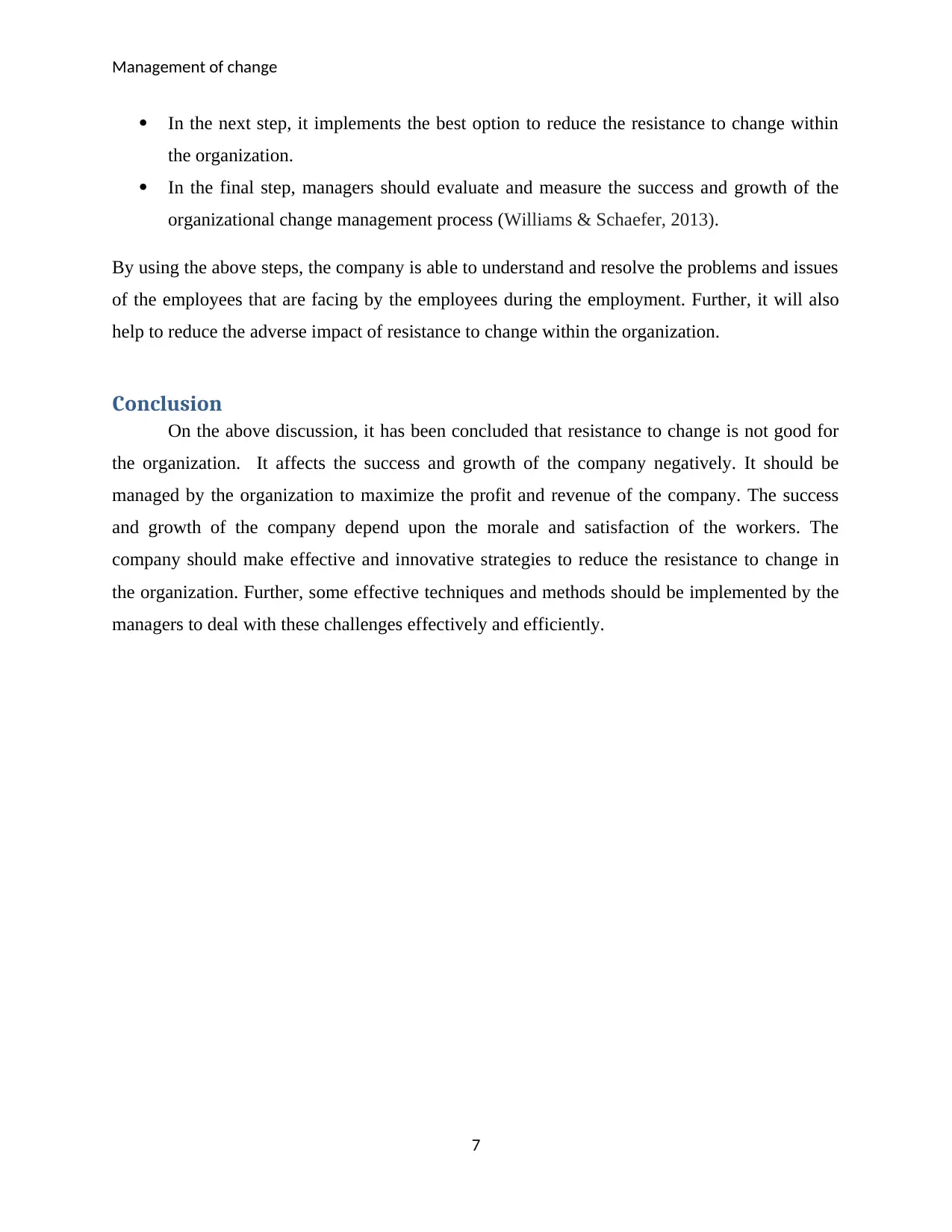
Management of change
In the next step, it implements the best option to reduce the resistance to change within
the organization.
In the final step, managers should evaluate and measure the success and growth of the
organizational change management process (Williams & Schaefer, 2013).
By using the above steps, the company is able to understand and resolve the problems and issues
of the employees that are facing by the employees during the employment. Further, it will also
help to reduce the adverse impact of resistance to change within the organization.
Conclusion
On the above discussion, it has been concluded that resistance to change is not good for
the organization. It affects the success and growth of the company negatively. It should be
managed by the organization to maximize the profit and revenue of the company. The success
and growth of the company depend upon the morale and satisfaction of the workers. The
company should make effective and innovative strategies to reduce the resistance to change in
the organization. Further, some effective techniques and methods should be implemented by the
managers to deal with these challenges effectively and efficiently.
7
In the next step, it implements the best option to reduce the resistance to change within
the organization.
In the final step, managers should evaluate and measure the success and growth of the
organizational change management process (Williams & Schaefer, 2013).
By using the above steps, the company is able to understand and resolve the problems and issues
of the employees that are facing by the employees during the employment. Further, it will also
help to reduce the adverse impact of resistance to change within the organization.
Conclusion
On the above discussion, it has been concluded that resistance to change is not good for
the organization. It affects the success and growth of the company negatively. It should be
managed by the organization to maximize the profit and revenue of the company. The success
and growth of the company depend upon the morale and satisfaction of the workers. The
company should make effective and innovative strategies to reduce the resistance to change in
the organization. Further, some effective techniques and methods should be implemented by the
managers to deal with these challenges effectively and efficiently.
7
Paraphrase This Document
Need a fresh take? Get an instant paraphrase of this document with our AI Paraphraser
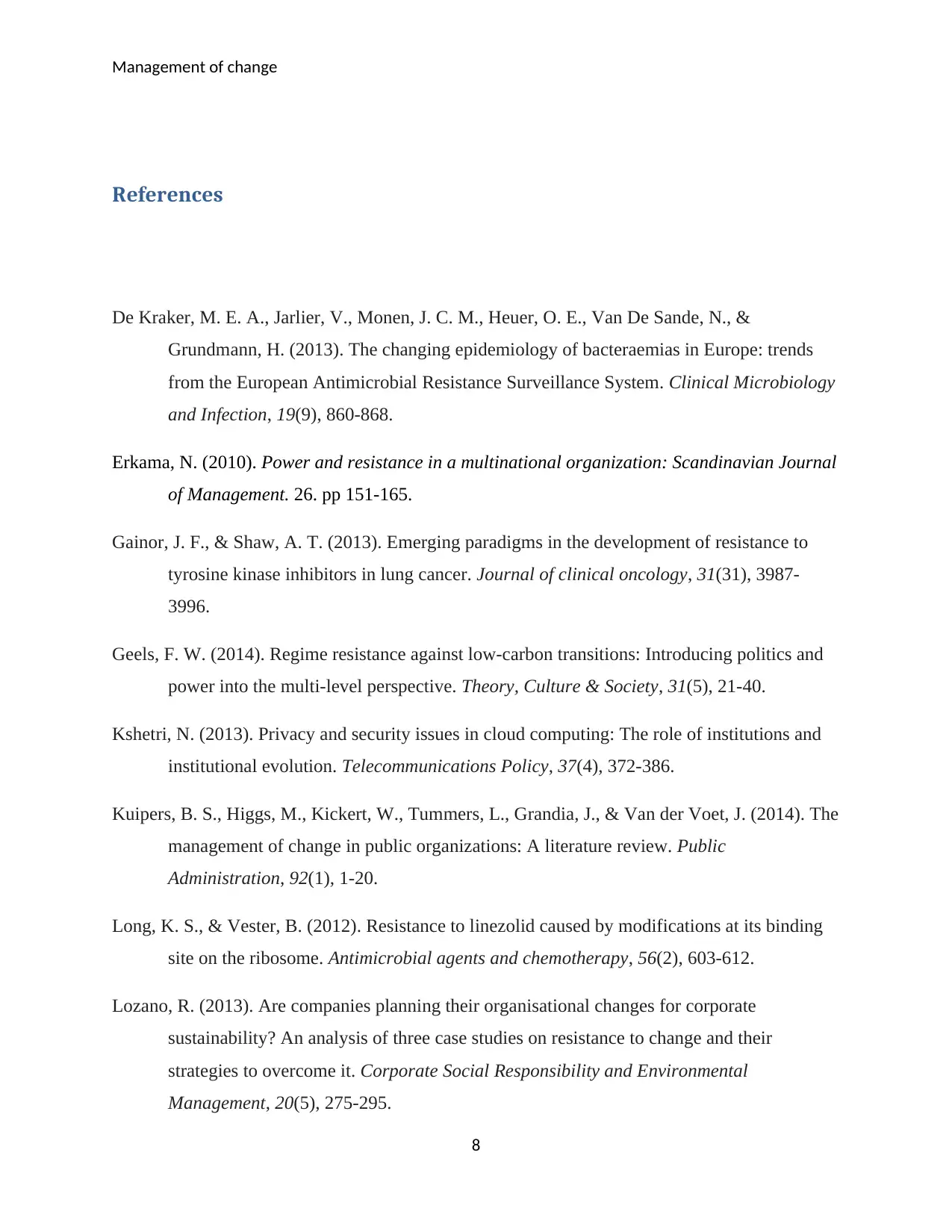
Management of change
References
De Kraker, M. E. A., Jarlier, V., Monen, J. C. M., Heuer, O. E., Van De Sande, N., &
Grundmann, H. (2013). The changing epidemiology of bacteraemias in Europe: trends
from the European Antimicrobial Resistance Surveillance System. Clinical Microbiology
and Infection, 19(9), 860-868.
Erkama, N. (2010). Power and resistance in a multinational organization: Scandinavian Journal
of Management. 26. pp 151-165.
Gainor, J. F., & Shaw, A. T. (2013). Emerging paradigms in the development of resistance to
tyrosine kinase inhibitors in lung cancer. Journal of clinical oncology, 31(31), 3987-
3996.
Geels, F. W. (2014). Regime resistance against low-carbon transitions: Introducing politics and
power into the multi-level perspective. Theory, Culture & Society, 31(5), 21-40.
Kshetri, N. (2013). Privacy and security issues in cloud computing: The role of institutions and
institutional evolution. Telecommunications Policy, 37(4), 372-386.
Kuipers, B. S., Higgs, M., Kickert, W., Tummers, L., Grandia, J., & Van der Voet, J. (2014). The
management of change in public organizations: A literature review. Public
Administration, 92(1), 1-20.
Long, K. S., & Vester, B. (2012). Resistance to linezolid caused by modifications at its binding
site on the ribosome. Antimicrobial agents and chemotherapy, 56(2), 603-612.
Lozano, R. (2013). Are companies planning their organisational changes for corporate
sustainability? An analysis of three case studies on resistance to change and their
strategies to overcome it. Corporate Social Responsibility and Environmental
Management, 20(5), 275-295.
8
References
De Kraker, M. E. A., Jarlier, V., Monen, J. C. M., Heuer, O. E., Van De Sande, N., &
Grundmann, H. (2013). The changing epidemiology of bacteraemias in Europe: trends
from the European Antimicrobial Resistance Surveillance System. Clinical Microbiology
and Infection, 19(9), 860-868.
Erkama, N. (2010). Power and resistance in a multinational organization: Scandinavian Journal
of Management. 26. pp 151-165.
Gainor, J. F., & Shaw, A. T. (2013). Emerging paradigms in the development of resistance to
tyrosine kinase inhibitors in lung cancer. Journal of clinical oncology, 31(31), 3987-
3996.
Geels, F. W. (2014). Regime resistance against low-carbon transitions: Introducing politics and
power into the multi-level perspective. Theory, Culture & Society, 31(5), 21-40.
Kshetri, N. (2013). Privacy and security issues in cloud computing: The role of institutions and
institutional evolution. Telecommunications Policy, 37(4), 372-386.
Kuipers, B. S., Higgs, M., Kickert, W., Tummers, L., Grandia, J., & Van der Voet, J. (2014). The
management of change in public organizations: A literature review. Public
Administration, 92(1), 1-20.
Long, K. S., & Vester, B. (2012). Resistance to linezolid caused by modifications at its binding
site on the ribosome. Antimicrobial agents and chemotherapy, 56(2), 603-612.
Lozano, R. (2013). Are companies planning their organisational changes for corporate
sustainability? An analysis of three case studies on resistance to change and their
strategies to overcome it. Corporate Social Responsibility and Environmental
Management, 20(5), 275-295.
8
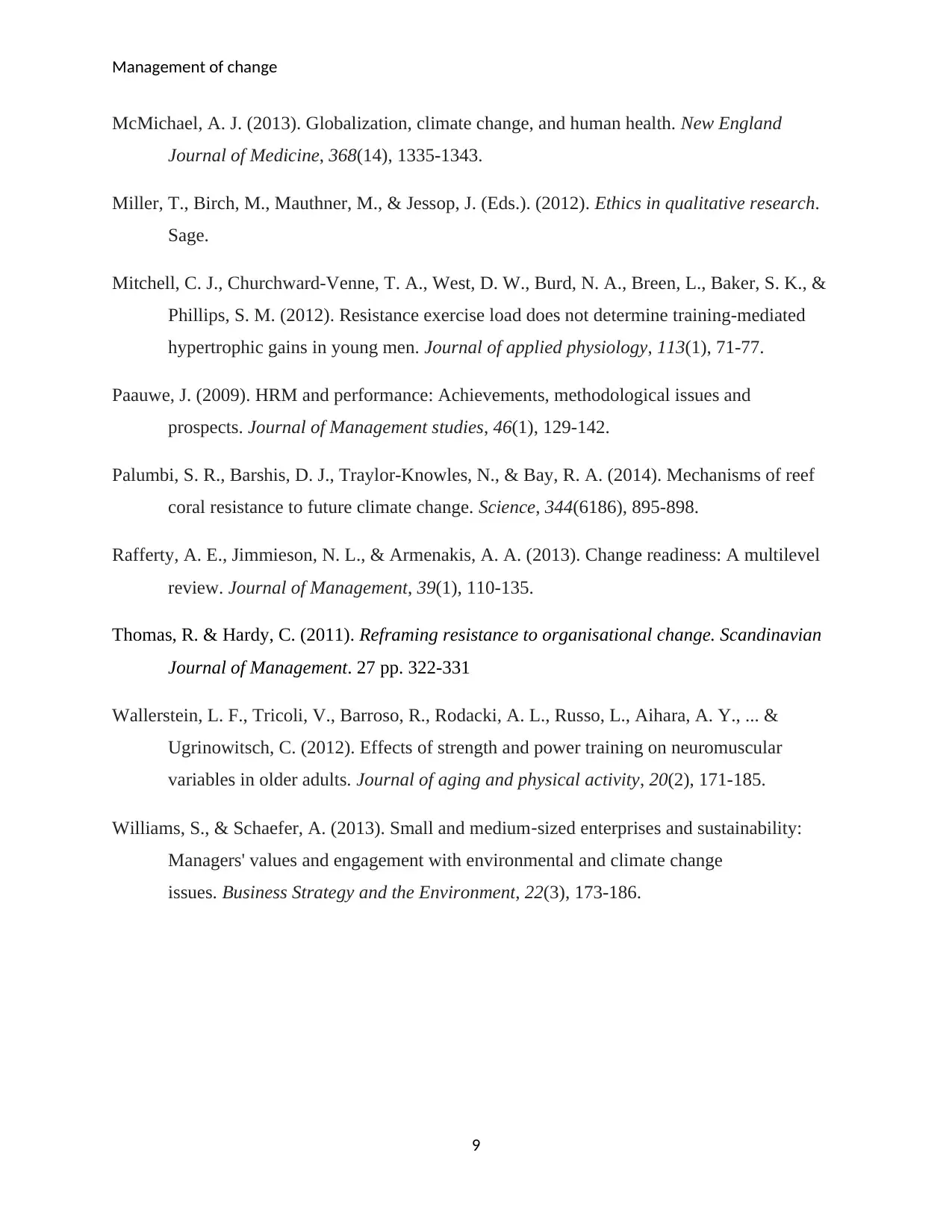
Management of change
McMichael, A. J. (2013). Globalization, climate change, and human health. New England
Journal of Medicine, 368(14), 1335-1343.
Miller, T., Birch, M., Mauthner, M., & Jessop, J. (Eds.). (2012). Ethics in qualitative research.
Sage.
Mitchell, C. J., Churchward-Venne, T. A., West, D. W., Burd, N. A., Breen, L., Baker, S. K., &
Phillips, S. M. (2012). Resistance exercise load does not determine training-mediated
hypertrophic gains in young men. Journal of applied physiology, 113(1), 71-77.
Paauwe, J. (2009). HRM and performance: Achievements, methodological issues and
prospects. Journal of Management studies, 46(1), 129-142.
Palumbi, S. R., Barshis, D. J., Traylor-Knowles, N., & Bay, R. A. (2014). Mechanisms of reef
coral resistance to future climate change. Science, 344(6186), 895-898.
Rafferty, A. E., Jimmieson, N. L., & Armenakis, A. A. (2013). Change readiness: A multilevel
review. Journal of Management, 39(1), 110-135.
Thomas, R. & Hardy, C. (2011). Reframing resistance to organisational change. Scandinavian
Journal of Management. 27 pp. 322-331
Wallerstein, L. F., Tricoli, V., Barroso, R., Rodacki, A. L., Russo, L., Aihara, A. Y., ... &
Ugrinowitsch, C. (2012). Effects of strength and power training on neuromuscular
variables in older adults. Journal of aging and physical activity, 20(2), 171-185.
Williams, S., & Schaefer, A. (2013). Small and medium‐sized enterprises and sustainability:
Managers' values and engagement with environmental and climate change
issues. Business Strategy and the Environment, 22(3), 173-186.
9
McMichael, A. J. (2013). Globalization, climate change, and human health. New England
Journal of Medicine, 368(14), 1335-1343.
Miller, T., Birch, M., Mauthner, M., & Jessop, J. (Eds.). (2012). Ethics in qualitative research.
Sage.
Mitchell, C. J., Churchward-Venne, T. A., West, D. W., Burd, N. A., Breen, L., Baker, S. K., &
Phillips, S. M. (2012). Resistance exercise load does not determine training-mediated
hypertrophic gains in young men. Journal of applied physiology, 113(1), 71-77.
Paauwe, J. (2009). HRM and performance: Achievements, methodological issues and
prospects. Journal of Management studies, 46(1), 129-142.
Palumbi, S. R., Barshis, D. J., Traylor-Knowles, N., & Bay, R. A. (2014). Mechanisms of reef
coral resistance to future climate change. Science, 344(6186), 895-898.
Rafferty, A. E., Jimmieson, N. L., & Armenakis, A. A. (2013). Change readiness: A multilevel
review. Journal of Management, 39(1), 110-135.
Thomas, R. & Hardy, C. (2011). Reframing resistance to organisational change. Scandinavian
Journal of Management. 27 pp. 322-331
Wallerstein, L. F., Tricoli, V., Barroso, R., Rodacki, A. L., Russo, L., Aihara, A. Y., ... &
Ugrinowitsch, C. (2012). Effects of strength and power training on neuromuscular
variables in older adults. Journal of aging and physical activity, 20(2), 171-185.
Williams, S., & Schaefer, A. (2013). Small and medium‐sized enterprises and sustainability:
Managers' values and engagement with environmental and climate change
issues. Business Strategy and the Environment, 22(3), 173-186.
9
⊘ This is a preview!⊘
Do you want full access?
Subscribe today to unlock all pages.

Trusted by 1+ million students worldwide
1 out of 9
Related Documents
Your All-in-One AI-Powered Toolkit for Academic Success.
+13062052269
info@desklib.com
Available 24*7 on WhatsApp / Email
![[object Object]](/_next/static/media/star-bottom.7253800d.svg)
Unlock your academic potential
Copyright © 2020–2025 A2Z Services. All Rights Reserved. Developed and managed by ZUCOL.





